64 Cores of Rendering Madness: The AMD Threadripper Pro 3995WX Review
by Dr. Ian Cutress on February 9, 2021 9:00 AM EST- Posted in
- CPUs
- AMD
- Lenovo
- ThinkStation
- Threadripper Pro
- WRX80
- 3995WX
CPU Tests: Simulation
Simulation and Science have a lot of overlap in the benchmarking world, however for this distinction we’re separating into two segments mostly based on the utility of the resulting data. The benchmarks that fall under Science have a distinct use for the data they output – in our Simulation section, these act more like synthetics but at some level are still trying to simulate a given environment.
DigiCortex v1.35: link
DigiCortex is a pet project for the visualization of neuron and synapse activity in the brain. The software comes with a variety of benchmark modes, and we take the small benchmark which runs a 32k neuron/1.8B synapse simulation, similar to a small slug.
The results on the output are given as a fraction of whether the system can simulate in real-time, so anything above a value of one is suitable for real-time work. The benchmark offers a 'no firing synapse' mode, which in essence detects DRAM and bus speed, however we take the firing mode which adds CPU work with every firing.
The software originally shipped with a benchmark that recorded the first few cycles and output a result. So while fast multi-threaded processors this made the benchmark last less than a few seconds, slow dual-core processors could be running for almost an hour. There is also the issue of DigiCortex starting with a base neuron/synapse map in ‘off mode’, giving a high result in the first few cycles as none of the nodes are currently active. We found that the performance settles down into a steady state after a while (when the model is actively in use), so we asked the author to allow for a ‘warm-up’ phase and for the benchmark to be the average over a second sample time.
For our test, we give the benchmark 20000 cycles to warm up and then take the data over the next 10000 cycles seconds for the test – on a modern processor this takes 30 seconds and 150 seconds respectively. This is then repeated a minimum of 10 times, with the first three results rejected. Results are shown as a multiple of real-time calculation.
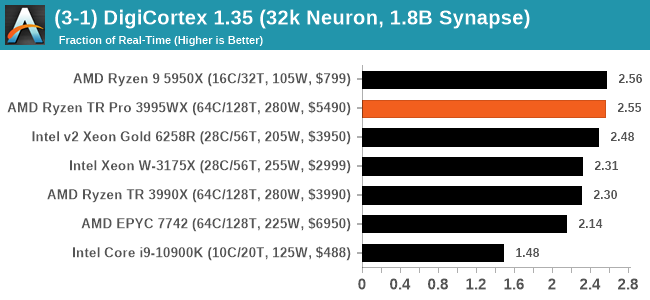
This test prefers monolithic silicon with proportionally lots of memory bandwidth, which means that we get somewhat of an equalling of results here. The top result in our benchmark database is actually single chiplet Ryzen.
Dwarf Fortress 0.44.12: Link
Another long standing request for our benchmark suite has been Dwarf Fortress, a popular management/roguelike indie video game, first launched in 2006 and still being regularly updated today, aiming for a Steam launch sometime in the future.
Emulating the ASCII interfaces of old, this title is a rather complex beast, which can generate environments subject to millennia of rule, famous faces, peasants, and key historical figures and events. The further you get into the game, depending on the size of the world, the slower it becomes as it has to simulate more famous people, more world events, and the natural way that humanoid creatures take over an environment. Like some kind of virus.
For our test we’re using DFMark. DFMark is a benchmark built by vorsgren on the Bay12Forums that gives two different modes built on DFHack: world generation and embark. These tests can be configured, but range anywhere from 3 minutes to several hours. After analyzing the test, we ended up going for three different world generation sizes:
- Small, a 65x65 world with 250 years, 10 civilizations and 4 megabeasts
- Medium, a 127x127 world with 550 years, 10 civilizations and 4 megabeasts
- Large, a 257x257 world with 550 years, 40 civilizations and 10 megabeasts
DFMark outputs the time to run any given test, so this is what we use for the output. We loop the small test for as many times possible in 10 minutes, the medium test for as many times in 30 minutes, and the large test for as many times in an hour.
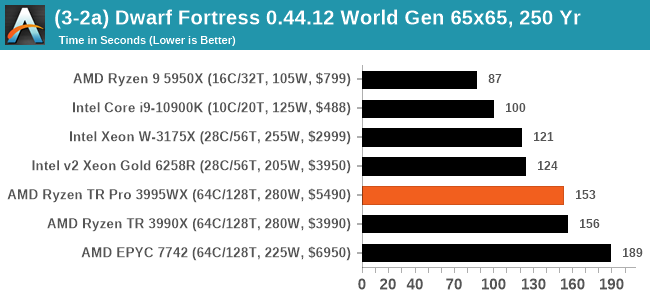
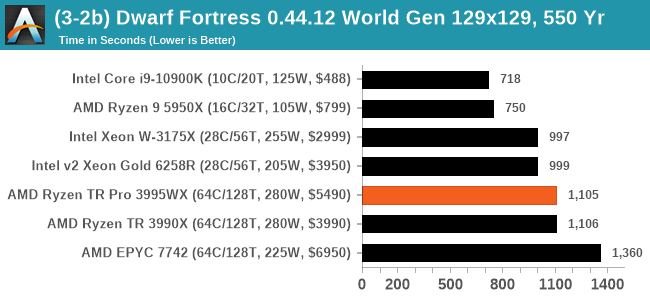
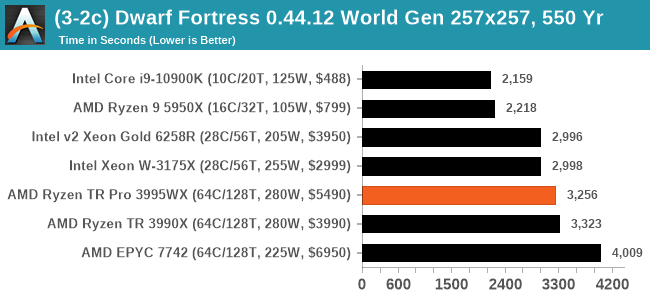
Dwarf Fortress is mainly single-thread limiting, hence the 64-core models at the back end of the queue. The TR parts are still a good bit faster than the EPYC.
Dolphin v5.0 Emulation: Link
Many emulators are often bound by single thread CPU performance, and general reports tended to suggest that Haswell provided a significant boost to emulator performance. This benchmark runs a Wii program that ray traces a complex 3D scene inside the Dolphin Wii emulator. Performance on this benchmark is a good proxy of the speed of Dolphin CPU emulation, which is an intensive single core task using most aspects of a CPU. Results are given in seconds, where the Wii itself scores 1051 seconds.
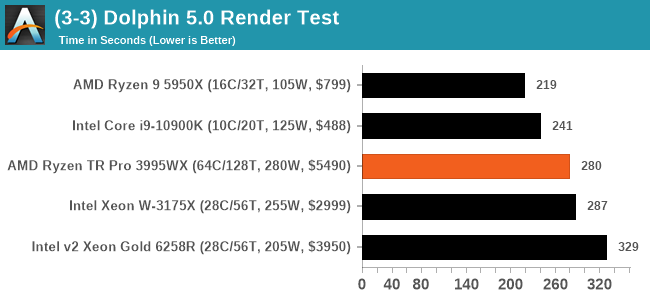
Similarly here, single thread performance matters.












118 Comments
View All Comments
Silma - Tuesday, February 9, 2021 - link
TLDR: unless you absolutely need a 3995WX feature not included in a 3990X, the 3990X is a much better choice: almost same performances, $1,500 less.ingwe - Tuesday, February 9, 2021 - link
Yeah absolutely. Still exciting to me with the increased DDR capacity.kgardas - Tuesday, February 9, 2021 - link
Well, not always! For some cases W-3175x was better and even for some cases poor small 5950x was better. So target application always matter here.For me AVX512 perf of 3175x is breath taking (8x speedup of AVX512 code in comparison with non-AVX!) and pity that AMD is not supporting this yet. Speaking about spec. code, Saphire Rappids AMX will be something to look for.
frbeckenbauer - Tuesday, February 9, 2021 - link
It's unlikely amd will ever implement AVX512 directly. It's too niche and takes up a huge amount of die space, you're better off going to GPU instead.Oxford Guy - Tuesday, February 9, 2021 - link
If AMD were to implement it, Intel has AVX1024 waiting in the wings.Smell This - Tuesday, February 9, 2021 - link
Get me the Nuke Plant ... STAT!
We have an order for Chipzillah AVX1024, and need more Gigawatts.
kgardas - Tuesday, February 9, 2021 - link
Not avx1024, but amx: https://fuse.wikichip.org/news/3600/the-x86-advanc...ishould - Tuesday, February 9, 2021 - link
Is AMX something that might be able to be implemented as a chiplet? If so, AMD might be going this route so the customers that need it can get itElstar - Friday, February 12, 2021 - link
I can't find a link to it, but during the Xeon Phi era (rest in peace), the Intel engineers were proud of the EVEX encoding scheme and that it could support AVX1024 or AVX2048 someday. I think now that Xeon Phi is dead and normal Xeons have embraced AVX512BW and AVX512VL, this dream is dead too.kgardas - Tuesday, February 9, 2021 - link
Look at the benchmark numbers and then think what TR will be able to do with proper avx512 support. Yes, AMD definitely needs to implement it. Also it'll need to implement AMX in the future if they would not like to become second class x86 citizen again.